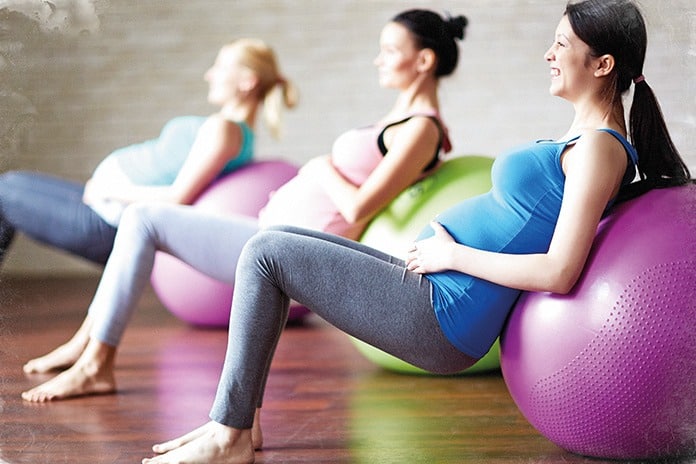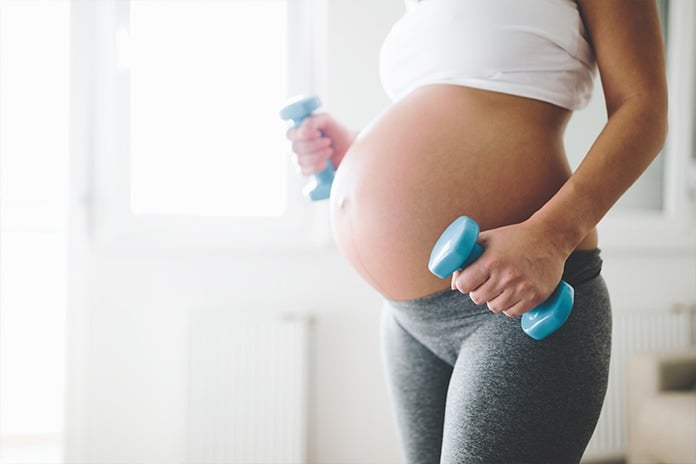Six of the best ways to exercise with your bump comfortably and safely
Words by MindBody Team
Weight training
Light weight training helps to tone up muscles and strengthen your core, so is a great prenatal exercise for the early stages of pregnancy (if weights were a regular part of your training schedule before). However, it’s advisable to stop after your second trimester.
If your doctor has agreed it’s safe for you to continue weight training, it’s best to avoid using heavy weights and any exercises that involve lying on your back, such as bench press.
Carolyn Logan, coach and sports therapist at MINDBODY studio CrossFit London, explains: “The main issues to note are when there is a feeling of strain or excessive fatigue that is different to the norm. As the baby grows in the uterus it starts to push other things out the way, sometimes it can push against big blood vessels in the abdomen. Since these blood vessels are behind the uterus, the syndrome can be made worse by lying on the back.”
Alex Miller, CrossFit London coach, adds: “The prenatal period is actually a good time to step away from heavy loading to give your body a break from intense stimulus. While we know heavier loading is the best way of making a change to your body, there are plenty of other ways to stay strong. Our go-to for teaching movement and ingraining great form is to perform exercises at a controlled tempo. For example, take five-six seconds to lower a weightless bar and five to ascend. You’ll find that you can keep your strength and improve both movement quality and body composition without having to load the bar. Focusing on comprehensive movements, like squats, can help strengthen the body correctly and even help towards reversing abdominal diastasis recti.”
Yoga
Yoga, one of the most popular prenatal classes, helps to strengthen your core muscles, ease back pain and maintain muscle tone. It’s a gentle exercise that’s also kind to your joints and helps you to relax and de-stress.
Jill Simpson, founder of MINDBODY studio Ebb&Flow, explains: “The prenatal classes we offer focus on postures and techniques to help strengthen the body and mind in a safe way and are designed so you can join them at any stage of your pregnancy. We address the key areas of pelvic floor, aching neck and shoulders, loss of stamina and maintaining flexibility. I would really encourage expectant mothers to practise yoga, as it can improve sleep, reduce stress and help maintain a healthy posture during pregnancy too.”

Pilates
Pilates is one of the most effective prenatal exercises as it targets the muscles that generally weaken during pregnancy. Erica Foulds, a master trainer at MINDBODY studio Ten Health & Fitness, explains: “During pregnancy, the body is constantly changing. Pilates is an effective and safe way to build the strength and endurance that will help you cope better with those changes. It’s also great for keeping the pelvis strong to assist the process of a natural birth; labour can last for several hours and core muscles will fatigue easily if they have not been trained throughout pregnancy. Mothers-to-be who regularly exercise their core muscles can therefore expect shorter labours and reduced lower back and pelvic pain, so I would definitely recommend it!”
As Pilates is also non-impact – when compared with other forms of exercise – the risk of injury is reduced, so not only is it physically beneficial and advisable, but knowing you’re exercising safely can also help to reduce anxiety and provide reassurance during classes.
Erica adds: “[Our] prenatal classes will be varied and less intense than our standard classes. They are structured around the changing requirements of a developing pregnancy to provide an effective workout from the first trimester through to full term, all the while staying completely safe for mother and baby.”
She does warn, however, that if you’re in your third trimester and have not attended classes during the earlier stages of your pregnancy, it’s not safe to start now.
Pelvic floor exercises
Any mum-to-be will be very familiar with pelvic floor exercises. These exercises are incredibly important during pregnancy, as they help to strengthen the muscles that come into great strain in pregnancy and childbirth. Stress incontinence is a problem many pregnant women suffer with, which can mean you leak small amounts of wee when exercising, coughing and sneezing. Luckily, pelvic floor exercises have been proven to help relieve stress incontinence if done on a regular basis.
Jill says: “Begin by sitting, standing or laying down in a comfortable position and squeeze and lift your pelvic floor muscles (these are the ones you use when you’re trying to hold in a wee)! Hold this contraction for up to ten seconds, then relax. Repeat ten times and aim to do three or four sets each day.”

Light cardio
While some women wouldn’t dream of doing cardio when pregnant, light aerobic exercise is an effective prenatal exercise. Brisk walking is the best exercise (for women who did not have a strenuous fitness regime before pregnancy) as it’s gentle but keeps you fit and healthy without jarring your knees and ankles. Aim to go on a brisk 30-minute walk four times a week.
A keen runner before you were pregnant? There is absolutely no harm in continuing to run into your pregnancy. Go easy and if you start to feel wheezy and out of breath – stop. If you never ran before pregnancy, then don’t start now! You should find another route of exercise instead, such as an aerobics class.
Swimming
Swimming is incredibly effective in working your heart and lungs without putting too much pressure on your joints. It can even help relieve swollen ankles, making it an ideal prenatal exercise for many women.



COMMENTS ARE OFF THIS POST